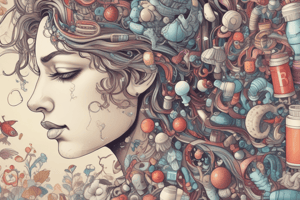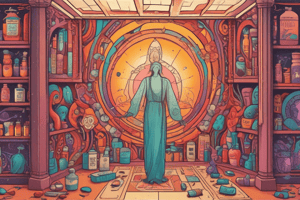Podcast
Questions and Answers
Which drug is primarily used to treat chronic neuropathic pain and also acts as a dual action antidepressant?
Which drug is primarily used to treat chronic neuropathic pain and also acts as a dual action antidepressant?
- Venlafaxine
- Selegiline
- Duloxetine (correct)
- Imipramine
What is the mechanism of action of Naloxone in opioid treatment?
What is the mechanism of action of Naloxone in opioid treatment?
- Full agonist
- Partial agonist
- Pure antagonist (correct)
- Weak agonist
Which of the following antidepressants also targets norepinephrine reuptake?
Which of the following antidepressants also targets norepinephrine reuptake?
- Duloxetine (correct)
- Gabapentin
- Selegiline
- Imipramine
Which substance is characterized as a cannabinoid antagonist that suppresses appetite?
Which substance is characterized as a cannabinoid antagonist that suppresses appetite?
What is the primary function of Suboxone in opioid treatment?
What is the primary function of Suboxone in opioid treatment?
Which drug acts as a melatonin agonist to aid sleep?
Which drug acts as a melatonin agonist to aid sleep?
Which drug is identified as a partial mu agonist used to limit respiratory depression and abuse potential?
Which drug is identified as a partial mu agonist used to limit respiratory depression and abuse potential?
Which type of drug is considered an effective treatment for alcohol withdrawal seizures?
Which type of drug is considered an effective treatment for alcohol withdrawal seizures?
Flashcards
Duloxetine's action
Duloxetine's action
Duloxetine treats pain by affecting nerve signals (neuropathic pain), and is also an antidepressant targeting both serotonin and norepinephrine
Morphine's receptor action
Morphine's receptor action
Morphine primarily binds to Mu (μ) opioid receptors within the body, causing a powerful effect.
Naloxone's function
Naloxone's function
Naloxone is used to counter opioid overdoses by blocking opioid receptors, preventing the dangerous effects.
Ramelteon's mechanism
Ramelteon's mechanism
Signup and view all the flashcards
Caffeine's receptor action
Caffeine's receptor action
Signup and view all the flashcards
Disulfiram's alcohol treatment
Disulfiram's alcohol treatment
Signup and view all the flashcards
Methadone's role in addiction
Methadone's role in addiction
Signup and view all the flashcards
Antidepressants pain relief
Antidepressants pain relief
Signup and view all the flashcards
Study Notes
Drugs and Their Mechanisms
-
Depression:
- Duloxetine: Treats chronic neuropathic pain, dual-action antidepressant, active metabolite is desvenlafaxine.
- Selegiline: Transdermal patch, effective in patients unresponsive to SSRIs and TCAs.
- Venlafaxine: Dual-action antidepressant, targets serotonin and norepinephrine reuptake.
- Impramine: A tricyclic antidepressant.
-
Pain and Opioids:
- Morphine, Codeine, Heroin: Pure Mu agonists.
- Naloxone: Pure antagonist, reverses opioid overdose.
- Buprenorphine: Partial Mu agonist, limits respiratory depression and abuse potential.
- Suboxone: Buprenorphine + Naloxone.
- Pentazocine: Weak Mu antagonist + Kappa agonist, analgesic but dysphoric effects.
- Fentanyl: Mu antagonist
- Tramadol: Mixed agonist.
- Laudanum: Alcohol + Opioids
- Salvinorin A: Targets Kappa receptors.
- Kratom: Targets Delta receptors.
- Aspirin/NSAIDs: Decrease inflammation.
- Gabapentin/Pregabalin: Decrease nociceptor excitation.
- Opioids: Decrease neurotransmitter release by nociceptors.
- Antidepressants/Opioids: Activate anti-pain pathways.
- Opioids: Influence cognitive and emotional processing.
-
Sleep:
- Ramelteon: Melatonin agonist.
- Suvorexant: Orexin receptor antagonist.
- Caffeine: Adenosine receptor antagonist.
- Barbiturates and Alcohol: Suppress REM sleep.
- Z-drugs (Zaleplon, Zolpidem, Eszopiclone): Varying durations of action.
-
Psychedelics:
- Scopolamine: Anticholinergic, sedation and twilight anesthesia.
- Ololiuqui: Chemically similar to serotonin.
- Bufotenine: Chemically similar to serotonin, found in toad skin.
- Psilocybin: Chemically similar to serotonin, found in mushrooms.
- MDMA: Enhances communication and empathy.
- LSD: Visual, auditory, and space/time distortions.
- Mescaline: Chemically similar to dopamine and norepinephrine.
- Ketamine: Antiglutamatergic, NMDA receptor antagonist.
- PCP: Antiglutamatergic.
- Salvinorin A: Kappa opioid antagonist.
-
Weed (Marijuana):
- Rimonabant: Cannabinoid antagonist, suppresses appetite.
- Carboxy THC: Identifies THC in urine tests.
- Sativex: Analgesic, THC + CBD combination, suppresses pain in inflammatory conditions.
-
Drinking (Alcohol):
- Diazepam: Prevents withdrawal seizures.
- Disulfiram: Elongates unpleasant effects of alcohol, prevents relapse.
- Naltrexone: Prevents relapse.
- Lamotrigine: Anticonvulsant.
-
Addiction:
- Naloxone: Heroin antagonist.
- Methadone: Heroin agonist.
- Nicotine patches: Cigarette alternative.
- Varenicline (Chantix): Partial nicotine agonist.
- Disulfiram (Antabuse): Alcohol aversive treatment.
- Suboxone: Aversive treatment for opioids.
Key Drug Targets and Actions
- Opioids: Primarily target Mu receptors, and also Kappa/Delta receptors in some cases, either as agonists or antagonists. Actions include pain relief, but also potential for respiratory depression and euphoria.
Studying That Suits You
Use AI to generate personalized quizzes and flashcards to suit your learning preferences.
Description
Explore the pharmacological mechanisms of various drugs used to treat depression and pain. This quiz covers antidepressants, opioids, and their effects on neuroreceptors. Test your knowledge on the specific actions and classifications of these medications.




